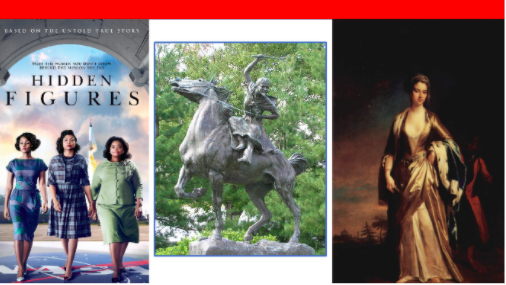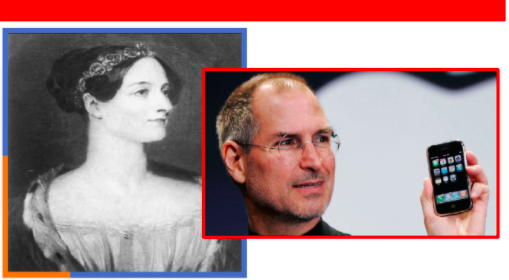Why Do We Need a Women’s History Month?
Issue 164 — March 29, 2021
First a fun quiz.
Do you recognize these women?
And what about these?
During the month of March, we honor those women and ourselves when we tell their stories and say their names.
We have Women’s History Month because women have so often been left out of history. Knowing that history helps you to know the value of your work, the why, and to understand your part in it, right? And as individuals, it enables us to uncover our true selves. To value our strengths and better understand our demons and deficits.
The top photo above includes (left) three of the Black women whose story was eventually told in the film Hidden Figures. Mary Jackson, Dorothy Vaughan, and Katherine Johnson were the brains without whom NASA astronaut John Glenn would never have been able to circle the Earth and walk on the Moon. Did you know the women’s names before you read the book or saw the movie?
In the middle is a statue of Sybil Ludington, who at age 16 rode farther and mustered more people to fight the British than Paul Revere (who might not even have been a real person). But unless you lived in her small Connecticut town, did you ever hear of her?
On the right, Lady Mary Montagu in the 18th century first noticed that in the midst of a raging smallpox epidemic, there were elderly Turkish women who had devised a way of inoculating people with a small amount of smallpox matter, after which they did not catch the disease which otherwise proved fatal or disfiguring to over one-fourth of the population. Never heard of her? But perhaps you have heard of Edward Jenner who took the credit. Yet Lady Montagu’s astute observation has led to the very concept of vaccines to prevent infectious diseases.
And what about the photo of five women above? Four of them are responsible for creating the vaccines that are saving humanity from the latest global pandemic. Did you know their names? Why not?
Sarah Gilbert (lower far right) developed the Oxford vaccine. Kizzmekia Corbett (top right) was hailed by Dr. Anthony Fauci as instrumental in developing the Moderna vaccine (left, top row).
Katalin Karikó, a Hungarian-born scientist behind the Pfizer vaccine has spent 40 years researching her belief in “the therapeutic potential of synthetic messenger RNA (mRNA), a technology that could open the door to a new generation of medical treatments and cures.” On the bottom left is Dr. Özlem Tureci, who cofounded BioNTech, the company that partnered with Pfizer to bring the vaccine they had developed to market. Note that her husband and cofounder is the centerpiece of the New York Times article, though she is the medical director and certainly deserves at least equal credit.
The fifth woman in that picture, Rosalind Franklin, made scientific discoveries about the structure of DNA and RNA that enabled the other researchers to develop the various new COVID vaccines. Yet until recently, Franklin’s name had virtually disappeared while the men she worked with, James Watson and Francis Crick, built on her work and won the Nobel Prize.
I teach a powerful program I developed based on research for my book No Excuses and subsequent women’s leadership development work since founding Take The Lead.
The curriculum includes 9 Leadership Power Tools to Advance Your Career, and it’s now available online as a self-directed course you can access anywhere any time.
For good reason, the first tool is “Know your history and you can create the future of your choice.”
If you don’t know where you’ve come from, it’s hard to embrace your own power to determine where you want to go. It’s hard even to see the options so you can set your intentions accordingly.
Ask yourself: how does your family history influence you? What women in history do you most admire? What women in your life?
Those are important elements of who we are and what we think we can be or do in our lives. Your history in effect forms the story of YOU.
It is important to embrace and claim your history, the hard parts and difficulties we have had as well as the positive moments. Your story is your power and your truth.
Great leaders know themselves deeply.
When we can’t see ourselves in the narrative of history, or in leadership roles today, there is an important consequence. It affects our heads, our self-worth, and our intentions to self-advocate as a movement.
If you can see it, you can be it.
And so there are three main points about this Power Tool.
First is the plain fact that half of humanity is underrepresented in what we learn about ourselves as humans. Steve Jobs could never have invented the iPhone if it had not been for Ada Lovelace, pictured below. She developed the algorithms that enables the computer programming we have today. She was working with Charles Bancroft who took the credit for her work.
Fortunately, Ada is getting revitalized thanks to the current initiatives aimed at getting women and girls into STEM fields.
2. Not knowing your history has the effect of lowering women’s intentions to lead. Because if you haven’t seen people who look like you in leadership roles, how do you see yourself in them? Add to that the messages we get from an early age that objectify our appearance and reward us for being small and quiet and thinking first about others. Because of our social conditioning to put others first, women and women’s movements have had a pattern of taking steps forward with great energy, courage, and passion, and then taking steps back of our own volition.
It’s almost as if each step forward was accompanied by doing the thing that we are socialized to do as women, which is put other people first. That happened with abolition, and with several other movements along the way. To me, the most poignant lesson was this: It took 70 years to get women’s suffrage from the time they started to try to get women the right to vote. And by the time they were able to codify it in the 19th amendment to the Constitution in 1920, the suffrage movement had narrowed their argument to, “Well, it doesn’t matter if women have the vote. Women will just vote like their husbands anyway.” And then that’s very much what happened.
At the turn of the 20th century, the women’s suffrage movement had a broad agenda. They were talking about many of the things we talk about today. Childcare, healthcare, fair wage issues — all of those things. But by the time they had secured the right to vote, they had dropped that entire agenda. Worse, they failed to be inclusive of women of color, thus abandoning an important constituency base as well as a critical element of moral power.
The result was that the movement dissipated. Rather than revitalize that progressive agenda, the movement fizzled. Some good things happened — like the voter education movement. But there was no, “Here’s what we need to do next.”
Only Alice Paul of the suffrage movement leaders in 1920 realized that a movement has to move, that power and energy come from moving forward not from standing still or backing off. Paul wrote the Equal Rights Amendment at that time, and it still hasn’t been ratified into the Constitution.
You can find other examples like Rosie the Riveter going back home to the kitchen after being invited into the workplace in WWII. Women were needed during wartime, but after Johnny came marching home, women relinquished their places at work.
And so we find ourselves facing that same assumption, that since we have seen a woman “first” almost everything and have changed laws and opened doors, that the job is done. There are no more problems or barriers.
But if the challenge of the 20th century was to change laws and open doors, the challenge of the 21st century is for women to walk through those doors and to take other women with them so that we can reach true parity.
3. What each of us can do to break out of these patterns and give amazing women like you their due: learn, teach, and make history.
When you know your history you can create the future of your choice. And, as George Santayana said, “Those who cannot remember the past are condemned to repeat it.”
The narrative of history has largely been written from the male lens, and it has been a narrative of war and the assumption of scarce resources. Women’s contributions and lives have scarcely been a blip on the screen. So you can learn about women’s history by reading and listening. You can teach by making sure that girls and young women learn the stories of women and see women role models. We can start by learning and telling our family histories. Then move on to researching and telling the stories of women, famous or more likely not, who have made a difference in any field of endeavor.
We can take credit for our own discoveries and accomplishments. And we can work to make women’s history a required course for all children. We can realize that every day, we are making tomorrow’s history.
We’ll know we have progressed in Power Tool #1 when women’s history is incorporated as simply — history.
Happy Women’s History Month. Perhaps if we do all of these things, we won’t need it any more.
GLORIA FELDT is the Cofounder and President of Take The Lead, a motivational speaker and expert women’s leadership developer for companies that want to build gender balance, and a bestselling author of four books, most recently No Excuses: 9 Ways Women Can Change How We Think About Power. Former President of Planned Parenthood Federation of America, she teaches “Women, Power, and Leadership” at Arizona State University and is a frequent media commentator. Learn more at www.gloriafeldt.com and www.taketheleadwomen.com. Tweet Gloria Feldt.





